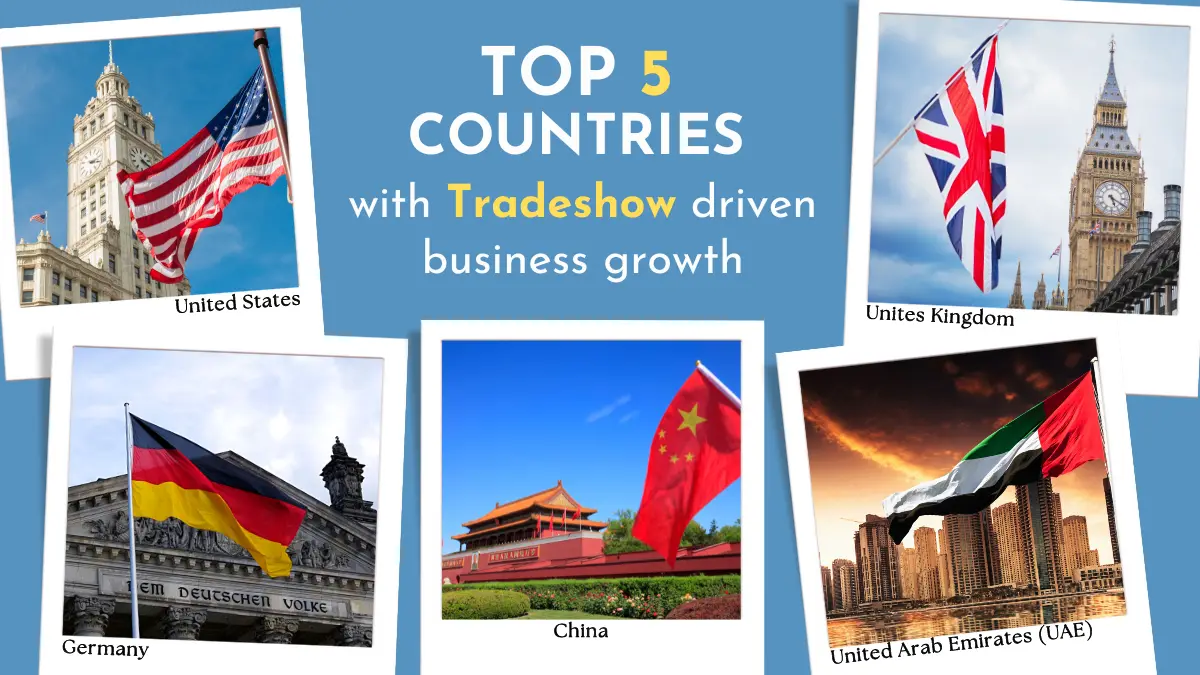Tradeshows and exhibitions play a crucial role in the global economy, with certain countries relying heavily on these events for economic growth, industry innovation, and international trade. In this blog, we’ll explore the top five countries globally that are heavily dependent on tradeshows and exhibitions, supported by illustrations and data.
1. United States
Overview:
The United States is the largest market for tradeshows and exhibitions in the world. With a diverse economy and a strong emphasis on innovation, the U.S. hosts some of the most significant global events across various industries, including technology, automotive, healthcare, and manufacturing.
Key Data:
- Economic Impact: The exhibition industry in the U.S. generated an estimated $101 billion in total economic impact in 2019.
- Employment: The industry supports over 1.3 million jobs, ranging from event management to hospitality and logistics.
- Major Events: Key events include CES (Consumer Electronics Show), SEMA Show, and BIO International Convention.
Illustration:
- CES: The Consumer Electronics Show in Las Vegas is a leading tradeshow that attracts over 170,000 attendees and generates more than $1 billion in business deals annually.
- Las Vegas: As a hub for tradeshows, Las Vegas alone hosts over 22,000 conventions and meetings each year, contributing significantly to the local economy.
2. Germany
Overview:
Germany is one of the leading countries in Europe for tradeshows and exhibitions, with a well-established tradition of hosting international events. The country is known for its high-quality infrastructure, strategic location, and strong industrial base.
Key Data:
- Economic Impact: The German exhibition industry contributes over €28 billion (approximately $32 billion) annually to the economy.
- Employment: The industry supports around 230,000 jobs in Germany, spanning event planning, venue management, and related services.
- Major Events: Notable tradeshows include Hannover Messe (industrial technology), IFA Berlin (consumer electronics), and Bauma (construction machinery).
Illustration:
- Hannover Messe: This is the world’s leading tradeshow for industrial technology, attracting over 200,000 visitors from around the globe and serving as a critical platform for industry innovation and partnerships.
- Cologne and Frankfurt: These cities are among the top destinations for international exhibitions, with venues like Koelnmesse and Messe Frankfurt hosting multiple major events each year.
3. China
Overview:
China has rapidly become a global powerhouse in the exhibition industry, driven by its large market size, robust manufacturing sector, and growing international trade. The country hosts numerous major tradeshows that attract participants from around the world.
Key Data:
- Economic Impact: The exhibition industry in China generated an estimated $55 billion in economic impact in 2019.
- Employment: The industry supports over 650,000 jobs, particularly in cities like Shanghai, Beijing, and Guangzhou.
- Major Events: Prominent tradeshows include the Canton Fair, China International Import Expo (CIIE), and Auto China.
Illustration:
- Canton Fair: The Canton Fair, held in Guangzhou, is the largest tradeshow in China and one of the most significant in the world, with over 60,000 booths and attracting around 200,000 buyers from more than 200 countries.
- Shanghai: As a key business hub, Shanghai hosts numerous international exhibitions, including the China International Import Expo (CIIE), which promotes trade and economic cooperation between China and other countries.
4. United Arab Emirates (UAE)
Overview:
The United Arab Emirates, particularly Dubai, has emerged as a leading global destination for tradeshows and exhibitions. The country’s strategic location, world-class infrastructure, and business-friendly environment have made it a hub for international events.
Key Data:
- Economic Impact: The exhibition industry in the UAE contributes approximately $6 billion annually to the economy.
- Employment: The sector supports around 100,000 jobs, primarily in event management, hospitality, and tourism.
- Major Events: Key events include GITEX Technology Week, Dubai Airshow, and Arab Health.
Illustration:
- Dubai Airshow: One of the largest and most important aerospace events in the world, the Dubai Airshow attracts over 80,000 trade visitors and generates billions of dollars in business deals.
- Dubai World Trade Centre (DWTC): The DWTC is the leading venue for exhibitions in the Middle East, hosting over 500 events annually, including major tradeshows that drive tourism and economic activity.
5. United Kingdom
Overview:
The United Kingdom is a significant player in the global exhibition industry, with London being a key destination for international events. The UK’s well-developed infrastructure, vibrant business environment, and strong financial sector make it a prime location for tradeshows.
Key Data:
- Economic Impact: The exhibition industry in the UK contributes around £11 billion (approximately $14 billion) annually to the economy.
- Employment: The sector supports over 100,000 jobs, spanning event planning, hospitality, and transport services.
- Major Events: Notable tradeshows include the Farnborough International Airshow, World Travel Market, and London Book Fair.
Illustration:
- Farnborough International Airshow: One of the world’s most prominent aerospace events, Farnborough showcases the latest in aviation technology and generates significant business deals, with the 2018 edition alone securing over $192 billion in orders.
- London: As a global business hub, London hosts numerous high-profile exhibitions, such as the World Travel Market, which attracts over 50,000 participants and drives substantial economic activity.
Conclusion
Tradeshows and exhibitions are vital economic drivers for these five countries, contributing billions of dollars to their economies, supporting millions of jobs, and fostering innovation and international trade. The success of these nations in leveraging the exhibition industry highlights the importance of tradeshows in promoting economic growth and strengthening global business networks.







